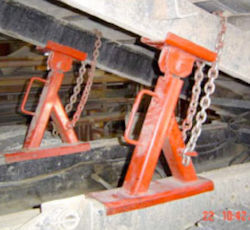Step 4. Dissipate or Restrain Potential Energy That Can't Be Isolated
Stored energy must be released or restrained after equipment has been de-energized.

If the energy could return to a hazardous level, make sure that it remains isolated from the equipment until all service work is finished. Sources of stored energy include:
- capacitors;
- coiled springs;
- elevated machine parts;
- rotating flywheels; and
- air, gas, steam, chemical, and hydraulic systems.
Safe practices for dissipating potential energy:
- Drain pressurized fluids or gases until internal pressure levels reach atmospheric levels.
- Discharge capacitors by grounding them.
- Double block and bleed process piping.
- Release or block tensioned springs.
- Ensure that all moving parts, such as flywheels and saw blades, have come to a complete stop.
- Allow equipment components to cool (or warm) to safe thermal levels.
Dissipating Stored Energy
Just shutting off the air supply to an automatically operated air valve or turning off a hydraulic power unit without bleeding off the pressure does not make up energy isolation. Energy isolation is achieved when there is no energy left to be released. For this reason, many companies refer to their energy control program as zero energy state (ZES).
Knowledge Check Choose the best answer for the question.
3-5. When has energy isolation effectively been achieved?
You forgot to answer the question!
